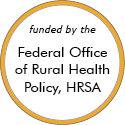Rural Project Examples: Effective
Browse rural projects that meet this collection's second highest level of evidence. For each example listed, the approach has been reported in a peer-reviewed publication.
Kentucky Homeplace
Updated/reviewed October 2023
- Need: Rural Appalachian Kentucky residents have deficits in health resources and health status, including high levels of cancer, heart disease, hypertension, asthma, and diabetes.
- Intervention: Kentucky Homeplace was created as a community health worker initiative to provide health coaching, increased access to health screenings, and other services.
- Results: From July 2001 to June 2023, over 189,338 rural residents were served. Preventive health strategies, screenings, educational services, and referrals are all offered at no charge to clients.
OHSU Rural Surgery Training
Updated/reviewed October 2023
- Need: General surgeons are needed in rural communities.
- Intervention: Oregon Health & Science University (OHSU) is sending residents to complete a general surgery rotation in rural southern Oregon.
- Results: 39% of the graduates of the rural residency program are now practicing in a rural setting. The residents remain more likely than other OHSU residents to enter general surgery practice and to serve in a community of fewer than 50,000 people.
Rural Medical Education Program at University of Illinois College of Medicine Rockford
Added October 2023
- Need: To recruit and train medical students who are committed to choosing rural practice.
- Intervention: An add-on curriculum that includes seminars, field trips, and clinical rotations in rural and underserved areas.
- Results: 436 students have graduated from the RMED program between 1997 and 2023, with 65% of program graduates practicing in towns of less than 50,000 people.
The Pacific Care Model: Charting the Course for Non-communicable Disease Prevention and Management
Updated/reviewed October 2023
- Need: The U.S. Associated Pacific Islands (USAPI) needed an efficient, effective, integrated method to improve primary care services that addressed the increased rates of non-communicable disease (NCD), the regional-specific phrase designating chronic disease.
- Intervention: Through specialized training, multidisciplinary teams from five of the region's health systems implemented the Chronic Care Model (CCM), an approach that targets healthcare system improvements, uses information technology, incorporates evidence-based disease management, and includes self-management support strengthened by community resources.
- Results: Aimed at diabetes management, teams developed a regional, culturally-relevant Non-Communicable Disease Collaborative Initiative that addresses chronic disease management challenges and strengthens healthcare quality and outcomes.
Health Coaches for Hypertension Control

Updated/reviewed September 2023
- Need: A cost-effective approach to help rural patients with hypertension learn to manage their condition.
- Intervention: Community volunteers trained as health coaches provided an 8-session hypertension management training program to hypertension patients older than 60, with an optional supplemental 8 sessions focused on nutrition and physical activity.
- Results: Just 16 weeks after the program, participants had improved systolic blood pressure, weight, and fasting glucose, greater knowledge of hypertension, and improved self-reported behaviors.
Meadows Diabetes Education Program

Updated/reviewed September 2023
- Need: To provide diabetes care and education services to those in rural southeast Georgia.
- Intervention: Diabetes outreach screening, education, and clinical care services were provided to participants in Toombs, Tattnall, and Montgomery counties.
- Results: Patients successfully learned self-management skills to lower their blood sugar, cholesterol, and blood pressure.
MU AHEC Summer Community Program
Updated/reviewed September 2023
- Need: Lack of healthcare providers, specifically physicians, in rural Missouri.
- Intervention: Rising second-year medical students at University of Missouri's School of Medicine are given the opportunity to participate in a clinical program in a rural community setting.
- Results: Almost half of the participants from 1996-2010 chose to practice in rural locations upon graduation.
Medical Legal Partnership of Southern Illinois
Updated/reviewed August 2023
- Need: Legal barriers often prevent economically disadvantaged people in Southern Illinois from obtaining positive health outcomes despite receiving medical care.
- Intervention: The Medical Legal Partnership of Southern Illinois (MLPSI) was formed to create a system where medical providers can refer patients in need of legal assistance to local attorneys.
- Results: Over 5,400 patients have utilized MLPSI since its founding in 2002. The program has relieved over $8.1 million in medical debt for both hospitals and patients.
Regional Oral Health Pathway

Updated/reviewed August 2023
- Need: To address the oral health needs of low-income uninsured and underinsured residents in rural Appalachia.
- Intervention: An oral health education program was implemented in Appalachian Maryland, Pennsylvania, and West Virginia.
- Results: This program increased oral health visits in the area and provided residents with valuable information on oral health resources and services.
Care for Our Elders/Wakanki Ewastepikte
Updated/reviewed June 2023
- Need: To provide Lakota elders with tools and opportunities for advance care planning.
- Intervention: An outreach program in South Dakota helps Lakota elders with advance care planning and wills by providing bilingual brochures and advance directive coaches.
- Results: Care for Our Elders saw an increase in the number of Lakota elders understanding the differences between a will and a living will and the need to have end-of-life discussions with family and healthcare providers.
